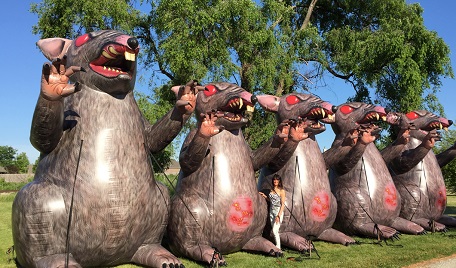A recent National Labor Relations Board decision will allow giant inflatable rats to remain at some union protest sites. But the commonly seen symbols still face a possible deflation in towns with strict permitting rules.
 Last week, the NLRB issued a decision in Lippert Components Inc. about the use of the inflatable rodent, knows as Scabby the Rat, to protest a secondary “neutral” employer and if the inflatable rat’s use violated the National Labor Relations Act. A neutral employer is a business that is not directly involved in a labor dispute but does some type of business with another company involved in a labor conflict.
Last week, the NLRB issued a decision in Lippert Components Inc. about the use of the inflatable rodent, knows as Scabby the Rat, to protest a secondary “neutral” employer and if the inflatable rat’s use violated the National Labor Relations Act. A neutral employer is a business that is not directly involved in a labor dispute but does some type of business with another company involved in a labor conflict.
Scabby the Rat was created in Chicago in the late 1980s and named for a term used for nonunion people who replaced workers during a labor dispute. Since then, Scabby has become a consistent presence at labor protests.
In this case, Lippert Components supplies components to the recreational vehicle industry. It rented equipment from a firm involved in a labor dispute with the International Union of Operating Engineers. One of Lippert’s customers was Thor Industries, which also hosted an RV trade show in Elkhart, Indiana. Lippert was inside the four-day trade show conducting business and a 12-foot version of Scabby the Rat was placed outside the building by the union along with two protest banners.
One of the key questions in the case involved a Supreme Court decision that protected neutral employers from coercive protests that outweighed the First Amendment free speech rights held by the union. In DeBartolo Corp. v. Florida Gulf Coast Building & Construction Trades Council (1989), the court drew a distinction between active union protests involving picketing and passive protests using handbills. On the one hand, the National Labor Relations Act’s Section 8(b)(4) considered threats, coercion and restraints arising from picketing at neutral sites as coercive and lacking First Amendment protection. On the other hand, the passing out of handbills constituted protected expressive speech by union workers.
“The loss of customers because they read a handbill urging them not to patronize a business, and not because they are intimidated by a line of picketers, is the result of mere persuasion, and the neutral who reacts is doing no more than what its customers honestly want it to do,” wrote Justice Byron White in the court’s unanimous opinion in DeBartolo. But in the case of Scabby the Rat, was the protest balloon sign more like an intimidating picket line or closer to a handbill asking trade show attendees to avoid products from Lippert?
In a 3-1 decision, the NLRB upheld an administrative law judge’s finding that Scabby the Rat didn’t violate Section 8(b)(4). Citing two prior NLRB rulings, the three-member majority found that “displaying banners or an inflatable rat near the entrance of a neutral employer, without more, does not ‘threaten, coerce, or restrain’ the neutral in violation of Section 8(b)(4).” Two NLRB board members agreed the union enjoyed the First Amendment’s free speech protection; the board chair believed the case raised enough issues that ran afoul of Section 8(b)(4) and the board didn’t need to consider the First Amendment question. The lone dissenter argued there was “coercion here far exceeding mere persuasion” due to Scabby’s location at the event’s entrance for a four-day period.
While the decision was hailed in the press as Scabby the Rat’s latest victory in court, any union that decides to deploy inflatable protest signs could face barriers not related to the NLRB.
In 2014, a Wisconsin town banned the rat for violating a general ordinance regulating signs in public locations. In Grand Chute, Wisconsin, Construction and General Laborers’ Local Union No. 330 sought damages after a 12-foot version of Scabby was evicted from a protest location across from a car dealership that was using non-union labor. The inflatable rat sat on a median strip within a busy thoroughfare. The union claimed the sign ordinance’s enforcement violated the First Amendment and it wanted compensation for costs related to deploying old-fashioned union pickets at the protest site.
A three-judge panel in the 7th Circuit Court of Appeals in 2019 held that Grand Chute’s 2014 ordinance was content neutral and designed to regulate private signs in the public right-of-way that could distract drivers. After an in-depth examination of the Code Enforcement Officer’s conduct, Chief Judge Diane Wood concluded that Grand Chute was not selectively banning signs based on their content.
In 2009, Scabby and his union owners prevailed in a similar case decided by New Jersey’s Supreme Court, State v. DeAngelo. In that controversy, Lawrence, N.J., officials had the protest sign deflated on the premise that Scabby’s use violated the town’s sign ordinance. The court believed Lawrence’s ordinance favored some signs and not others. In one example, the ordinance banned the use of inflatable signs like Scabby the Rat but permitted large balloon signs at the opening of a new business. The judges concluded the ordinance favored commercial over non-commercial speech. Also, the protest rat was tethered to a public sidewalk, which presented other free-speech issues.
Going forward, union officials who deploy Scabby the Rat at protest sites will need to be aware of the protections provided to them under the National Labor Relations Act, the finer points of the First Amendment, and the power of local governments to regulate sign usage.
Scott Bomboy is the editor in chief of the National Constitution Center.







